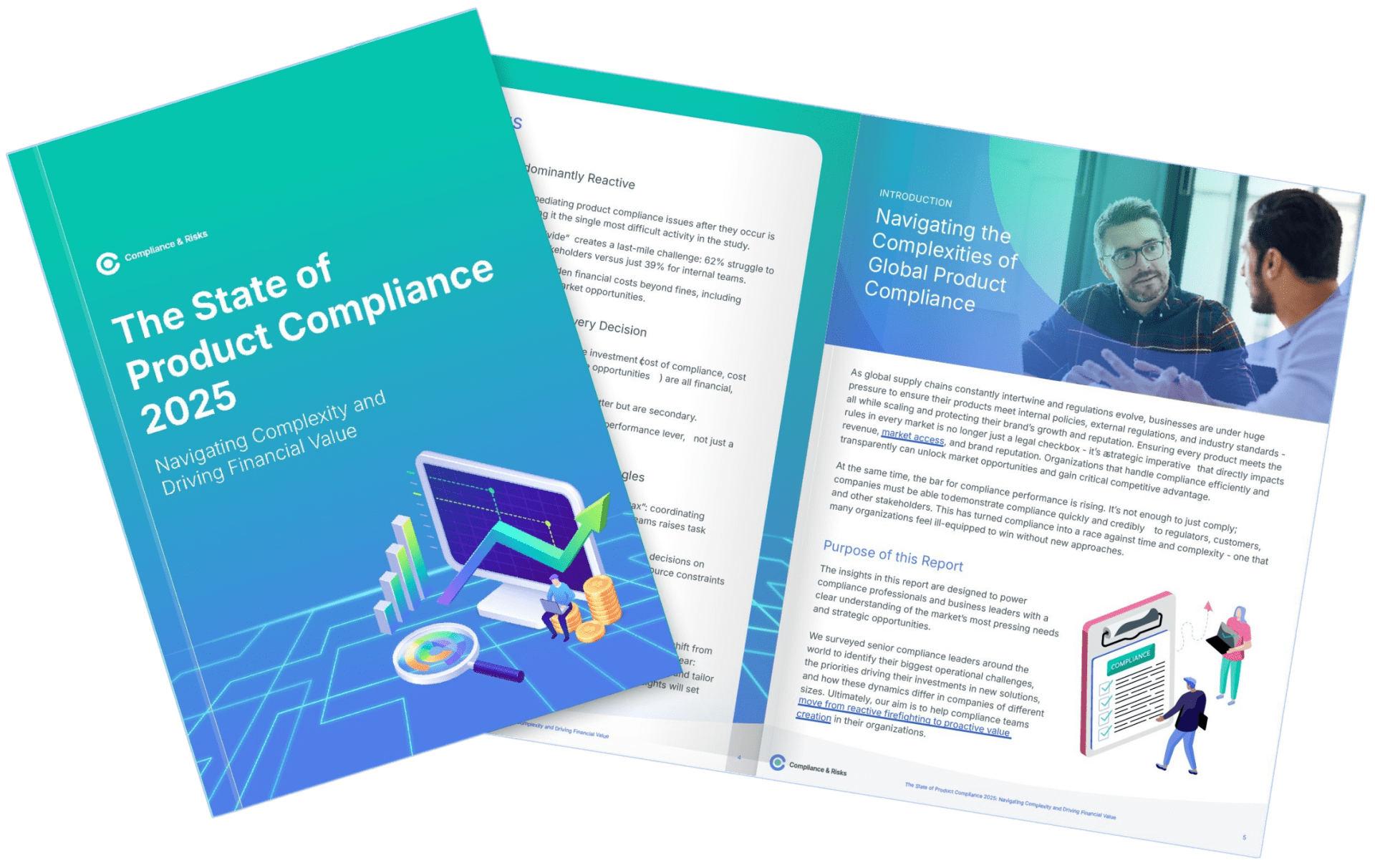
The Hidden Cost of Compliance Firefighting: Why Reactive Strategies Are Bleeding Your Budget

THIS BLOG WAS WRITTEN BY THE COMPLIANCE & RISKS MARKETING TEAM TO INFORM AND ENGAGE. HOWEVER, COMPLEX REGULATORY QUESTIONS REQUIRE SPECIALIST KNOWLEDGE. TO GET ACCURATE, EXPERT ANSWERS, PLEASE CLICK “ASK AN EXPERT.”
Most product compliance teams aren’t short on effort – they’re short on leverage. Our 2025 research shows the dominant pain point is late-stage remediation, with 69% of leaders saying fixing issues after they surface is their hardest task. Layer in a 23-point “evidence divide” – 62% struggling to prove compliance to external stakeholders vs. 39% internally – and you get an expensive cycle of fire drills, delayed launches, and avoidable risk.
This deep dive explains how reactive strategies quietly drain budgets, reputations, and runway – and how to start breaking the cycle. If your organization wants out of crisis mode, this is your playbook.
Table of Contents
- Why Firefighting Dominates – and Drains
- The Evidence Divide: Where Budgets Go to Die
- The Real Cost of Reactive Compliance
- Signals You’re Stuck in Crisis Mode
- What the Winners Do Differently (Teaser)
- AI Overview: Quick Answers
- FAQs
- Next Step: Download the Full Report
Why Firefighting Dominates – and Drains
69% of leaders rate remediation as the hardest compliance task. Why does it keep winning your calendar?
- Late visibility. Requirements aren’t fully mapped into product design, so gaps are discovered just before audits, certifications, or launches.
- Siloed information. Evidence lives across PLM, quality, legal, procurement, and regional teams—each with different taxonomies and owners.
- Ad hoc orchestration. When an issue hits, coordinating engineering, suppliers, legal, and regional leads becomes a bespoke project (again).
- Punitive timelines. Markets and customers don’t wait. Every day spent firefighting carries opportunity costs.
The loss isn’t only fines or rework. It’s the invisible drag on speed, morale, and credibility with the board.
The Evidence Divide: Where Budgets Go to Die
Our data surfaces a persistent last-mile problem: providing defensible evidence to external stakeholders is 23 points harder (62% vs. 39% internal). Three reasons it gets expensive fast:
- Ambiguity about “what good looks like.” Determining exactly which proofs are necessary for a given product/market is hard – leaders report 54% difficulty just defining the evidence set.
- Manual compilation under deadline. Even when you know the target, compiling audit-ready packages under time pressure leads to overtime, consulting spend, and quality slips.
- Jurisdictional fragmentation. Slightly different expectations by market multiply effort and error.
You may be compliant in practice – but if you can’t prove it instantly and credibly, you’ll still pay in delays, escalations, or lost deals.

The State of Product Compliance 2025: Navigating Complexity & Driving Financial Value
Fresh insights from 500 global compliance leaders – uncover the biggest challenges, priorities, and opportunities shaping compliance this year.
The Real Cost of Reactive Compliance
Use this model to quantify the drag of firefighting. You don’t need exact dollars – directionally correct inputs will make the pattern obvious.
| Cost Category | What It Looks Like | How It Shows Up on P&L/Plan |
| Rework & Engineering Churn | Late design changes, supplier do-overs, repeated testing | Opex spikes; missed milestones; increased COGS |
| Launch Delays & Revenue Risk | Stop-ships, missed seasonal windows, blocked market entries | Deferred revenue; lost market share; penalty clauses |
| Audit & Certification Overage | Rush audits, consulting support, translation under deadline | Unplanned vendor/consulting spend; premium fees |
| Opportunity Cost | Leaders pulled into crisis meetings; product teams frozen | Fewer strategic projects shipped this quarter |
| Reputation & Trust | Customer escalations; regulator scrutiny after weak evidence | Longer deal cycles; stricter audit regimes next time |
Quick back-of-the-envelope:
- Take last year’s count of late-stage compliance issues × average hours per issue × blended hourly rate.
- Add average revenue deferral per delayed launch × number of delays.
- Add external spend (expedited audits, consultants, translations).
- You’ll have a conservative view of what firefighting costs – before reputational drag.
Signals You’re Stuck in Crisis Mode
- Evidence is a project, not a product. Each audit requires bespoke hunting and formatting of documents.
- “Who owns this?” emails proliferate. RACI ambiguity around evidence management and design coverage.
- Meetings spike before every gate. Most cross-functional collaboration happens only when a deadline looms.
- Rework is normalized. Late fixes are treated as inevitable rather than preventable.
- Wins don’t compound. Lessons learned aren’t codified into reusable templates or system rules.
If three or more resonate, you’re paying the firefighting tax.
What the Winners Do Differently (Teaser)
Without giving away the full playbook, leaders breaking the cycle consistently do three things:
- Shift left on requirements. They embed compliance rules into design controls and supplier onboarding – so coverage exists before testing and certification.
- Productize evidence. Evidence is captured at the point of work, normalized, and instantly organized by product/market – so audit packages are “one-click” instead of “all-hands.”
- Finance-grade metrics. They align roadmaps to CFO-level outcomes (cost of compliance, cost of violations, revenue at risk, revenue opportunity) and report progress against those levers.
Want the how-to? The full report details a 4-step framework to move from reactive to proactive compliance.
AI Overview: Quick Answers
What is compliance firefighting?
Operating primarily in remediation – fixing issues after they surface – rather than preventing them through early-lifecycle coverage and ready-to-prove evidence.
Why is reactive compliance so costly?
Because late fixes multiply engineering rework, delay launches, require rush audits/consultants, and erode stakeholder trust – costs that rarely show up in a single line item.
How do I quantify our firefighting tax?
Add rework hours × rate, deferred revenue from delays, and external rush spend. Even rough estimates will reveal material impact.
What’s the first move to escape crisis mode?
Productize evidence. Make proofs capture-by-default and package-on-demand; it lowers audit risk immediately and frees cycles to shift left on requirements.
Which metrics convince executives?
Lead with cost of compliance, cost of violations, revenue at risk, and revenue opportunity – the four most cited decision drivers in our survey.
FAQs
- We already pass audits – why change? Passing is table stakes. The premium goes to teams that can prove compliance instantly and expand markets faster with less overage.
- We’re mid-market with lean teams – can we afford this? You can’t afford not to. Mid-size firms face sharper go/no-go pressure; decision intelligence and productized evidence reduce both risk and overhead.
- Isn’t this just a tooling problem? Tools matter, but value comes from codifying rules into design controls and treating evidence as a first-class product. Technology amplifies a clear operating model.
- How quickly will we see impact? Evidence productization yields near-term wins (fewer audit escalations, faster responses). Shifting-left compounds gains across launches over subsequent quarters.
Download the Full Report
Ready to stop paying the firefighting tax and see what the winners do differently? Get the benchmarks, the 4-step framework, and executive-ready metrics.
Download the complete State of Product Compliance 2025 report to move from reactive to proactive – starting now.


